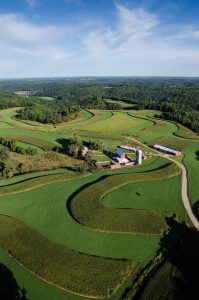Contact: Steven Deller, 608-263-6251, scdeller@wisc.edu
Wisconsin’s farms and agricultural businesses generate $104.8 billion in economic activity and 437,700 jobs, based on data for 2017, according to a new study from the University of Wisconsin–Madison. This is an increase from a 2012 study that found agriculture generated $88.3 billion in economic activity and 413,500 jobs in the state.
“The status of agriculture in Wisconsin has received significant attention in 2019 and has raised concerns about the health of the agricultural industry and its role in the Wisconsin economy,” says Steven Deller, Division of Extension community development economist and professor in the Department of Agricultural and Applied Economics at UW–Madison. “Despite currently weak commodity prices, particularly within dairy, agriculture remains an important part of the Wisconsin economy.”
Deller’s study is conducted every five years going back to the 1990s. For the purposes of the current study, agriculture is composed of two parts: on-farm production and food processing. Deller found that the bulk of the growth in the contribution of agriculture to the Wisconsin economy between 2012 and 2017 is growth in the food processing sector.
“These two parts of agriculture can be thought of as two sides to the same coin and as one does better the other does better,” says Deller. “The continued weak net farm income may put the food processing industry at risk. There is a clear balancing act between ensuring a healthy farm economy while continuing to promote growth in food processing.”
“The results of this analysis are very interesting, that while on-farm activity was not a major contributor to the increase in the economic impact, as a whole, the economic contribution of agriculture increased,” says Heidi Johnson, Extension Interim Agriculture Institute Director. “But this doesn’t soften the financial blow that many farms in Wisconsin are taking under continued depressed commodity prices”
Karl Martin, Extension Dean and Director says, “Information from this study also allows UW–Madison Extension to explore opportunities to provide relevant resources to individuals and communities through our educational programming. Extension is committed to finding practical, research-based solutions that support the agricultural economy in Wisconsin”
Here’s how agriculture’s $104.8 billion economic impact breaks down:
- “All agriculture,” combined on-farm and food processing, contributes $104.8 billion to industrial revenues (16.4% of the state total), 435,700 jobs (11.8%), $22.5 billion to labor income (11.3%), and $37.6 billion to total income (11.6%).
- On-farm activity contributes $22.0 billion to industrial sales or revenue (3.5% of the state total), 154,000 jobs (4.1%), $5.8 billion to labor income (2.9%), and $9.8 billion to total income (3.0%).
- Food processing activity contributes $82.7 billion to industrial sales (13.0% of the state total), 282,000 jobs (7.6%), $22.5 billion to labor income (8.4%), and $37.6 billion to total income (8.6%).
- Dairy, combining both on-farm and dairy processing, contributes $45.6 billion to industrial revenues (7.1% of the state total), 157,100 jobs (4.2%), $9.0 billion to labor income (4.5%) and $15.1 billion to total income (4.7%). Dairy processing accounts for roughly two-thirds of this contribution.
- The economic activity supported by agriculture results in state and local government tax revenues of $2.9 billion, which is roughly 7.4% of “own source revenues.”
- The bulk of the growth in the contribution of agriculture to the Wisconsin economy between 2012 and 2017 is growth in the food processing sector.
- Foreign exports of agricultural products (on-farm and processing) accounts for $4.9 billion in industry revenue (0.8% of Wisconsin total), 21,539 jobs (0.6%), about $1.1 billion in labor income (0.5%) and $1.8 billion in total income (0.6%). Additionally, the economic activity generated by agricultural foreign exports creates $129.7 million in state and local tax revenues.
The full report, titled “Contribution of Agriculture to the Wisconsin Economy: Updated for 2017,” is online and can be found at https://go.wisc.edu/i6947n
Support for this work was provided in part by the Dairy Farmers of Wisconsin; the University of Wisconsin–Madison Division of Extension’s Center for Community and Economic Development through its Economic Development Administration University Center; and the Office of the Dean, University of Wisconsin–Madison Division of Extension.




